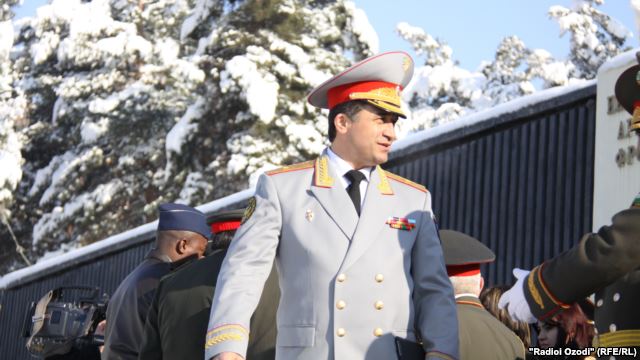
Tajikistan’s Government Uses Recent Violence to Neutralize Opposition
Publication: Eurasia Daily Monitor Volume: 12 Issue: 171
By:

On September 4, a group of armed men linked to former Deputy Defense Minister Abduhalim Nazarzoda attacked police checkpoints in Dushanbe and Vahdat. Nazarzoda and his followers fled to the Romit gorge, some thirty miles to the northeast of the capital city. Following a counter-insurgency operation, the security services killed Nazarzoda and 11 of his followers on September 16 (YouTube, September 16). A total of 25 militants died in the operation, and the security services detained a further 125 suspects (Interfax, Sept 16). The regime lost 14 law enforcement officers, including the commander of the special operations group of the State Committee for National Security, Colonel Rustam Amakiyev (Lenta, September 16).
According to the official version of events, Major-General Nazarzoda was acting on the orders of the country’s leading opposition party, the Islamic Renaissance Party (IRPT). On September 16, the Prosecutor General accused party leader Muhiddin Kabiri, of orchestrating the attacks (Khovar [Dushanbe], September 16). In his statement, the Prosecutor General implicated 13 senior party members in the violence, including First Deputy Chairman Saidumar Husayni, Deputy Chairman Muhammadali Hait and Spokesman Hikmatullo Saifullozoda. Plain clothes officers quickly raided the homes of the activists and took them away (Radio Ozodi, September 17). The Ministry of Interior has vowed to seek the help of Interpol to secure the extradition of Kabiri, who is currently in exile in Istanbul (Asia Plus, September 18). The IRPT’s leader flatly denies the government’s allegations against him (Radio Ozodi, September 17).
Given the IRPT’s stated commitment to a multi-party system and gradualist approach to reform in Tajikistan, the accusations of the party’s involvement in the early-September armed attacks are difficult to justify; and the regime has changed its story a number of times. President Rahmon initially labeled Major-General Nazarzoda an “Islamic State sympathizer,” who tried to lead a coup against the government (Nezavisimaya Gazeta, September 7). Although Tajikistani officials highlighted Nazarzoda’s civil war–era membership in the party (which was then a key coalition member of the United Tajik Opposition), they only formally accused the IRPT of involvement in the September 4 attacks after having neutralized Nazarzoda and his ability to offer a different story. Indeed, in his only recorded statement on the events, Nazarzoda said that the regime plotted to remove him for refusing to agree with the government’s recent banning of the IRPT (see EDM, September 11). When he heard that he was going to be targeted, Nazarzoda assembled supporters and decided to fight his way out (TajInfo, September 6). This explanation is more plausible than the government narrative. If the attacks were premeditated, they were abysmally planned; Nazarzoda let the government capture almost his entire weapons cache on the first day (Ozodagon, September 4).
Instead of posing a real threat to the regime, the September attacks offered an opportunity to remove a potentially disloyal commander and to completely eliminate the country’s leading opposition party. Nazarzoda was one of the last remaining United Tajik Opposition commanders in government. The 1997 peace deal allocated 30 percent of government posts to the opposition. But since then, the regime has arrested, killed and exiled most of these former commanders. Therefore, rather than plots by outside forces, struggles within the Tajikistani state itself ultimately caused the recent outbreak of violence in this Central Asian republic. This process of regime consolidation has resulted in sporadic armed attacks in Tajikistan. For instance, in 2008, the head of the paramilitary police, Oleg Zakarchenko, was killed when he tried to move against former United Tajik Opposition commander Mirzokhuja Ahmadov, whose forces controlled the Rasht Valley (Fergananews.com, February 4, 2008). Conflict between the government and local commanders had resulted in the deaths of over a hundred people in the Rasht Valley between 2009 and 2011.
These inter-elite struggles are not only about political influence, they are also about economic resources. Notably, Nazarzoda had used his political influence to run a construction business and buy a bread factory, nine houses, over fifty cars and three dachas in Varzob (YouTube, September 16). The regime has moved swiftly to requisition these assets, along with those owned by the IRPT and its leader, Muhiddin Kabiri (IslamNews, September 14).
Nazarzoda’s defection legitimized the regime’s final move to eliminate the IRPT. This process has been going on for a number of years, but has intensified since the March elections, when the opposition party lost its remaining two seats in the parliament. In June, the state newspaper Jumhuriyat accused Kabiri of illegally buying property (Jumhuriyat, June 16). Kabiri, who was then outside the country, became effectively exiled. At the same time, party deputies began abandoning the IRPT en-masse, in televised resignations (YouTube, June 23). In August, the government closed the party’s main office due to an “unresolved dispute about the legality of the building’s acquisition” (Radio Ozodi, August 25). On August 28, the Ministry of Justice cited a lack of popular support as grounds to ban the party (Khovar, August 28).
Nazarzoda’s defection has allowed the regime to put the final nail in the IRPT’s coffin. Now, with its leader fighting extradition and its senior members arrested, the Islamic Renaissance Party appears to have been confined to history, and Tajikistan has effectively become a one-party state.




